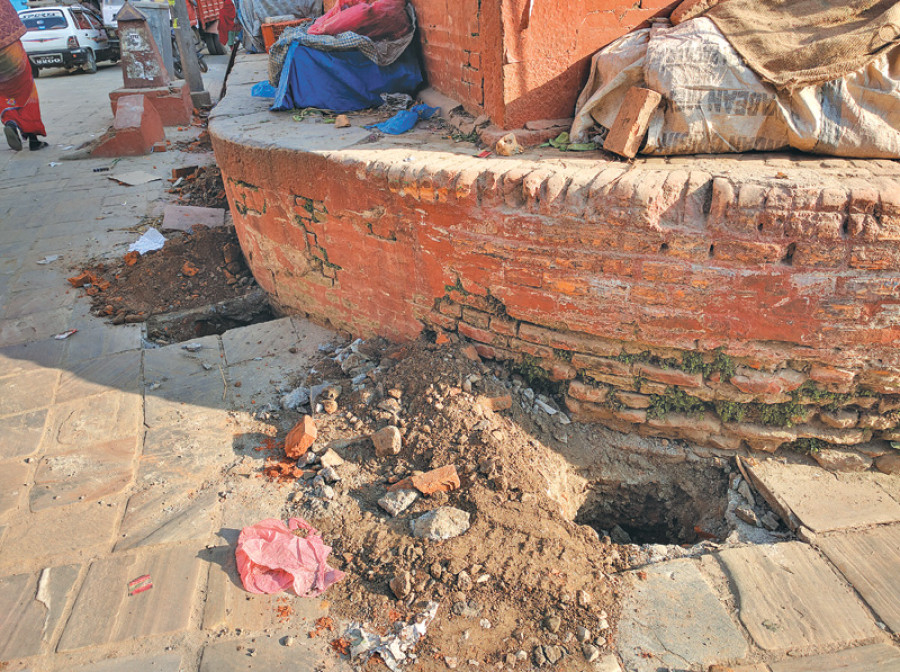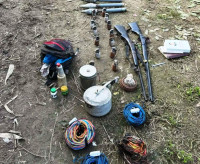National
Jaisi Dega rekindles debate over heritage reconstruction
At a time when reconstruction of heritage sites in Kathmandu Valley has been mired in protest and criticism, the use of heavy drilling tools at the 17th century Jaisi Dega, commonly known as Jaisi Dewal Temple, has drawn flak from the local community, activists and heritage conservationists.
Samipa Khanal & Sanjit Pradhananga
At a time when reconstruction of heritage sites in Kathmandu Valley has been mired in protest and criticism, the use of heavy drilling tools at the 17th century Jaisi Dega, commonly known as Jaisi Dewal Temple, has drawn flak from the local community, activists and heritage conservationists.
As part of the Kathmandu Metropolitan City (KMC)’s drive to fence off the premises of important heritage sites, Jai Ambe Construction Company had been subcontracted by the metropolis to cordon off the temple.
But the use of electric jackhammers to dig pits around the perimeter of the temple—with disregard for the sub-surface heritage that lie underneath—has irked locals no end.
“Seeing heavy drilling equipment being used at such an important heritage site was both alarming and infuriating,” said Alok Tuladhar, a heritage conservation activist. “It is not necessary to dig holes in the ground for fencing. Strong fences can be put up with clamps—just like in Patan Durbar Square where temples have been protected without causing any harm.”
As people took to social media to oppose the use of heavy machineries at the heritage site that dates back to 1668 AD, Suman Shrestha, a user, wrote: “A jackhammer has no place in the preservation of ancient monuments.”
Blatant use of such heavy equipment at Jaisi Dega follows a string of controversies this week regarding the rebuilding of heritage sites in the Valley, particularly in and around Kathmandu Durbar Square.
On Tuesday, locals cordoned off the premises of Dus Avatar Temple in Basantapur, accusing the contractors of insensitivity towards the site and lack of transparency in the reconstruction process. Earlier this week, it also emerged that another contractor had used beer bottles instead of bricks while fencing off the iconic Maju Dega Temple at Basantapur.
Earlier, reconstruction of a temple at Ranipokhari had also drawn criticism for failing to comply with archaeological norms. Unesco had also expressed its concerns about “inappropriate rebuilding of Ranipokhari”.
When contacted, Prakash Khanal, the contractor fencing Jaisi Dega, said, “We have a subcontract of approximately Rs 700,000 for the project. As my workers were suddenly sent home [by protesting locals], we are anxious about the continuity of the work. This is the first time our company has received a tender to work on the reconstruction of a heritage site.”
The Department of Archaeology (DoA), a body to monitor the reconstruction of monuments, admitted its failure to monitor the reconstruction work in the Valley.
“We have not been able to find experienced contractors,” said Gopal Jha, an engineer at the DoA. “The contractors working on archaeological sites are the ones who construct roads.”
With over 750 monuments damaged in the Gorkha Earthquake in 2015—with 133 sites completely reduced to rubble and 617 suffering partial damage—there have been debates over how heritage sites should be rebuilt. Conservation activists and locals have been raising concerns over the “tender system” of reconstruction just as construction contracts are being handed out to the lowest bidder.
The UN’s cultural agency had also earlier drawn the attention of concerned bodies to the need of appropriate reconstruction, saying sites of historical and religious significance should be rebuilt slowly and properly rather than quickly.
Meanwhile, conservation activists have been constantly calling for involving local communities in reconstruction work. If local communities are not involved in the rebuilding of the sites—like they have been for centuries—at the very least, the construction process needs to be transparent and should be done in consultation with all the stakeholders, they said.
The 17th century Jaisi Dega lies 200 meters south of Kathmandu Durbar Square. The revered Shiva shrine plays a crucial role during the Indra Jatra festival. The temple, which is considered a prototype for the larger and more elaborate Maju Dega Temple, was completely destroyed in the 2015 earthquake.




 11.12°C Kathmandu
11.12°C Kathmandu
%20(1).jpg&w=200&height=120)














